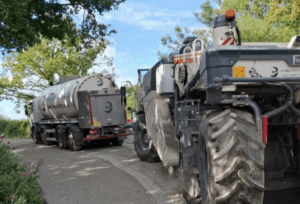VolkerHighways and Bath & North East Somerset Council have completed remedial work to Charlton Road, Keynsham, using innovative ‘in-situ’ recycling. This is a method of reconstruction which takes place entirely on-site, eliminating wastage and reducing carbon emissions.
Working with specialist contractor, SPL, the team used their latest recycling plant to first pulverise the existing carriageway then mix a blended cement binder while adding water to create a hydraulically bound foundation layer. The layer uses 97% of the recycled existing road material, with just 3% new materials, which is then compacted and re-profiled to reduce the likelihood of the road failing, in the future.
To ensure the location was suitable for this method of work, site testing was undertaken to make sure the existing road material was appropriate and compliant. Tar testing was also carried out during this exercise.
Charlton Road is a busy road, just South of Keynsham, and due to the complexity of the work, local diversions were ongoing for several weeks. In addition, Parkhouse Lane, just off Charlton Road, is a dead-end residential road. To minimise disruption to residents, work began at the Northern End of the scheme to complete the recycling of the first 150m of road.
The completed recycled layer receives a spray of bituminous emulsion which prevents drying out and so the hydration of the recycled layer can take place slowly. The emulsion is protected using a covering of bituminous grit. This temporary surface allows the carriageway to be trafficked and so after the first day, access for Parkhouse Lane residents was enabled.
Thanks to improved efficiency, the scheme was completed ahead of programme, allowing surfacing to take place sooner, and the road to be opened ahead of time. Carbon savings of 193 tonnes were derived during the scheme, that’s the equivalent of driving around the world 34 times! In addition, the process saved 316 lorry movements thanks to the in-situ recycling method.
The speed of the process enabled the road to receive a long-term fix, in a short period of time, which should last around 15 years. Minimal intervention should be required going forward and in the unlikely event the recycling requires deeper treatment in the future, the material can be recycled again.























